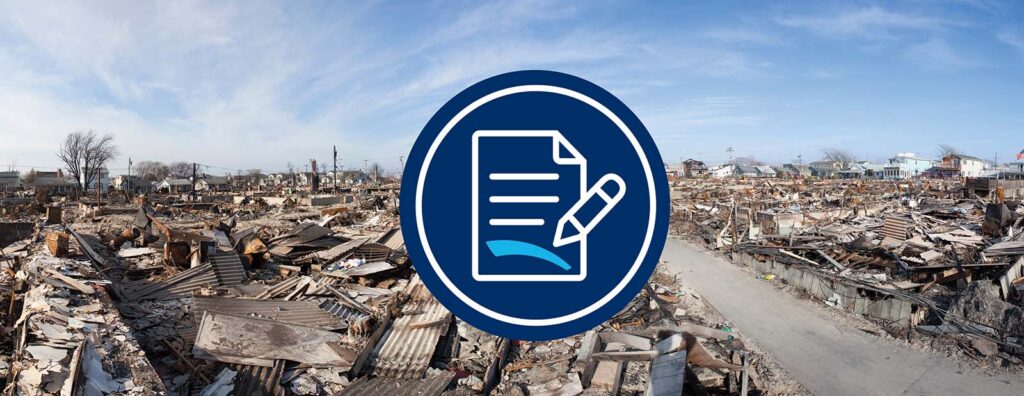The National Association of Counties (NACo), with support from The Pew Charitable Trusts (Pew), organized a roundtable in February 2022 with federal, state, and county officials to discuss challenges related to intergovernmental coordination in disaster resiliency. In the report, Findings From 2022 Intergovernmental Roundtable on Disaster Resiliency, several significant challenges were identified, including:
- Capacity: Local governments often lack the resources to respond and recover from disasters adequately.
- Costs: The rising frequency and severity of disasters make budgeting challenging due to unpredictable expenses dispersed across governments, the private sector, and residents.
- Federal Support: Despite the essential support that federal agencies can offer, many communities face barriers in grant administration, resulting in delayed financial support, sometimes as long as four years post-disaster.
- Focus Disparity: There’s a heightened emphasis on recovery efforts, overshadowing crucial preparedness and mitigation.
In February 2023, a second roundtable was held, concentrating on formulating solutions. It highlighted the need for a clear roadmap to enhance local disaster resilience capacity and the intergovernmental roles in ensuring community resilience as identified in the report, Findings From 2023 Intergovernmental Roundtable on Disaster Resilience: Defining and Building Capacity for Disaster Mitigation.
Defining resiliency and the role it plays across governments
The Federal Emergency Management Agency’s (FEMA) definition of resilience encompasses prevention, protection, mitigation, response, and threat recovery. Resilience pertains to infrastructure robustness, community networks, education, and training to adapt to emergencies. Furthermore, the roles in disaster resilience vary across governmental levels:
- The federal government offers financial aid, response measures, and hazard mitigation through FEMA, following a structured process.
- States manage these grants, adhering to federal compliance, and often distribute a portion to local governments.
- Local governments, such as counties, lead immediate disaster response efforts, regardless of their available resources, as detailed in FEMA’s National Response Framework.
The 2023 roundtable highlighted uneven local capacity for disaster resilience across counties due to variations in local revenue from land valuation. This disparity affects funding for recovery and federal disaster grants. To enhance outcomes for residents and reduce reliance on state and federal aid, there’s a need to define, measure, and improve local capacity. Participants identified the following.
Six essential elements of disaster resilience and proposed strategies to bolster local capabilities
During the roundtable, participants identified the following as the essential elements to build disaster resilience capacity:
- Funding: During the Intergovernmental Roundtable on Disaster Resilience, funding emerged as a pivotal component for disaster mitigation. A key challenge identified was the complexity of federal grant programs. While they are crucial for disaster mitigation, especially for smaller counties, navigating these grants can be highly resource intensive. The intricacy of programs, notably FEMA’s Building Resiliency in Communities (BRIC), and shifting scoring criteria make obtaining federal funds daunting. However, states have stepped up to bridge the gap. For instance, Texas offers matching federal grants and application support, while Florida’s Resilient Florida Program simplifies the grant application process for local entities. Additionally, Louisiana has established LITACorp, which aids localities in securing Infrastructure Investment and Jobs Act (IIJA) grants by providing matching funds and professional consultation.
- Staffing: Staffing was recognized by roundtable participants as the second most crucial indicator for disaster mitigation capacity. Counties prioritize dedicated agencies over just personnel, with most mitigation staff funded by general funds supplemented by grants. State and local resilience offices are pivotal in directing mitigation efforts, although their necessity varies across jurisdictions. Essential roles in these offices range from grant writers to environmental scientists. The flexibility to employ short-term consultants, like in Jacksonville/Duval County, Florida, can provide new insights and jumpstart projects. County leaders call for a clearer guide on best practices in resilience-building to suit varying local needs.
- Authority: State and local capacity to mitigate hazards depends heavily on the authority to enact and enforce policies, especially concerning zoning and planning. Local authority, defined by state constitutions and laws, varies widely; only 20 states provide counties with significant control over zoning and planning. For instance, Texas counties’ limited authority affects their ability to adopt the latest hazard-resistant building codes, impacting grant eligibility. In contrast, Florida allows counties to guide development aligned with resilience goals by giving them substantial planning authority. As seen in Texas and Louisiana, the power to initiate land purchasing in disaster-prone areas is another crucial mitigation tool, but its success is contingent on community acceptance.
- Data & Data Analytics: Effective disaster mitigation is rooted in robust data collection and analysis. The importance of this was highlighted by Chatham County’s study on its sea level trend from 1935 to 2021 to guide resilience planning. However, data utilization varies; some areas still rely on outdated flood maps from the 1980s. Federal agencies, such as the National Oceanic and Atmospheric Administration (NOAA), support local decision-makers by providing contemporary data. In 2022, NOAA published its Interagency Sea Level Rise Technical Report and an accompanying Application Guide, helping bridge scientific findings with practitioner requirements. NOAA also offers Coastal County Profiles, visually representing resilience data for U.S. coastal counties. These resources aim to empower local leaders in decision-making, combining economics, health, and safety considerations. The consensus among stakeholders is that resilience efforts need comprehensive support regarding funding, staffing, policy-making authority, partnerships, and quality data. Achieving long-term community buy-in demands a clear articulation of risk perceptions to ensure appropriate preparedness.
- Partnerships: Partnerships are vital in boosting local disaster resilience. Regional collaborations, such as Florida’s Southeast Florida Regional Climate Change Compact, streamline resources and expertise across counties. Local universities, like in Louisiana and Texas aid in data gathering and planning. The private sector, especially in areas like Jacksonville/Duval County, drives resilience initiatives and emphasizes the economic risks of unpreparedness. Louisiana’s new program to enhance coastal coverage underscores insurance’s role in disaster recovery. Moreover, collaborations with defense institutions, including the U.S. Department of Defense’s (DOD) Office of Local Defense Community Cooperation (OLDCC) and Readiness and Environmental Protection Integration (REPI), support community resilience, as seen in partnerships with Naval Station Mayport and Marine Corps Recruit Depot Parris Island.
- Education and Improved Risk Perception: Understanding risk is pivotal for lasting community resilience. Policymakers are instrumental in guiding local mitigation planning, but the influence of their efforts can wane with leadership changes, especially when election cycles outstrip disaster occurrences. Sustaining the community’s memory of significant disasters ensures continued preparedness. Contrary to concerns about potential negative impacts on tourism or local business, a well-prepared community can be an attractive prospect. There’s an emphasized need to educate budgetary authorities on the worth of investing in resilience-building measures to sidestep expensive recovery initiatives.
Public perception of risk is essential. An accurate understanding can prompt individuals to incorporate resilience in personal decisions, such as housing choices or purchasing relevant insurance. As new individuals settle in hazard-prone areas, local leaders must educate them about past resilience strategies and protective policies. With FEMA’s support, Harris County has launched the MAAPnext project, offering an interactive platform combining various data sources to enlighten the public on flood risks and provide recommendations, aiding in decision-making for safety and property protection.
Effective collaboration between all stakeholders builds community resilience
Disaster resilience requires collective effort. It mandates effective collaboration across states, local governments, industries, and governmental tiers. Despite distinct roles at different governmental levels, counties’ direct connection to residents emphasizes the importance of boosting local capacity to promptly manage and rebound from disasters. Both state and federal entities can play pivotal roles in enhancing this capacity. Cohesive coordination is the agreed-upon goal among roundtable participants.
Integrating all stakeholders, including private enterprises and academic institutions, from the onset of resilience planning ensures better results than isolated efforts. Local jurisdictions can merge planning, economic strategies, and climate analytics, by establishing and staffing dedicated resilience offices crafting holistic policy recommendations for community resilience.



